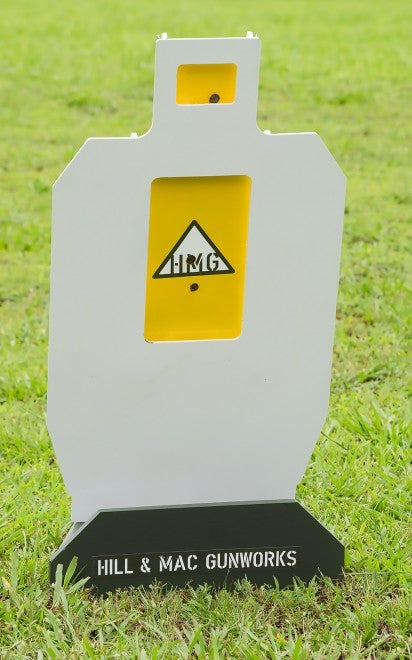Optimizing ammunition for 9mm carbines
Oleg Volk 07.08.15

Pistol-caliber carbines are an odd category of firearm. Some people question their very right to exist, for they aren’t as powerful as rifles but, thanks mainly to the NFA regulations requiring long barrels and the designer’s penchant for simple blowback operation, are as bulky and as hard-kicking as real rifles. Sensible ammunition selection is a big factor in optimizing pistol-caliber long guns. However, as with most things, it is only possible to optimize for some of the many goals at once.
Optimizing for price is the simplest approach: buy whatever ammunition is available cheaply that still runs in your carbine. If all you shoot is paper, you train a lot, and you aren’t shooting for long-range accuracy, the cheapest ball will do. Using 9mm also allows the use of just about any gun range and not just those with rifle-rated backstops. In some locations, that alone can save much time and gas money.
If you shoot steel instead of paper, then frangible ammunition would be the way to go. In my experience, frangibles aren’t as accurate as regular ball, but it will make no difference for hand-held fire at ten yards.
If noise mitigation is your goal, then subsonic ammunition is the obvious first step. Then either a sound suppressor or, if navigating NFA regulations and paying for the device and its tax stamp isn’t practical, a noise-diverting linear compensator, which is exactly what I added to the Sub2000mk2 using the 1/2×28″ threads. Subsonic 9x19mm ammo comes in two bullet weights, 147gr and 158gr. While 158 seems like the obvious choice with velocity fixed not to exceed 1050fps or so, why not raise the projectile weight? I found that few carbines shoot it accurately. Test both in your weapon to verify.
If terminal effectiveness is required, then any of the many mainstream hollow points will work well enough. 124gr seems to be the sweet spot; although lighter weight projectiles gain more velocity from the longer barrel than mid-weight or heavy bullets, the increase in velocity may cause the bullets to over-expand or fragment, limiting penetration.
Optimizing for accuracy becomes a matter of careful testing. Often, the sights and even more often the shooter are the limiting factors. I found that enlisting a former Marine marksmanship instructor as the tester helps with that last variable.
With the carbine rested on a sandbag and a variety of ammunition, we ended up with quite a spread of results. 158gr subsonics gave a shotgun-like pattern nearly 4 inches across. The best result of the day came from experimental batch of 110gr all-copper ammunition loaded by Maker Bullets.
The group shot with Sub2000mk2, bullet center to bullet center, is 3/4″ or 3MOA. This is almost as good as the 2.5MOA achieved with production OATH Halo all-copper solid. The 135gr Halo gets up to 1250fps from carbines and has correspondingly good penetration, if that’s the terminal effect you seek. 110gr expanding Tango ammunition at 1350fps showed accuracy almost as good.
The experimental ammunition we used came in 77, 110 and 147gr weights. The two lighter bullets showed identical expansion in gelatin despite the difference in weight and build. The distance between petal tips is 3/4″, but the heavier load penetrated 16″ and lighter load 12″.

Since mid-weight bullets produce deeper wound channels of the same size, why even bother with lighter projectiles? With relatively fast powder used, 77gr is a bit faster than 100gr, 1750fps to 1450fps. That translates into a flatter trajectory out to 400 yards, well past any reasonable employment of 9mm for point targets. At that range, terminal performance is around the level of 25ACP. While the lighter load is slightly less accurate than the mid-weight, the practical result may be superior for targets as guesstimated distances. I am looking forward to testing more of Maker Bullet loads with slower powders to see if we can get higher velocities without +P pressures.
Reducing the weight further to 50 grains, we get Liberty frangible loads. They were quite accurate in pistols but less impressive from the carbine with 2.5″ group or 10MOA. While the 2550fps muzzle velocity can’t be translated into medium-range results–I had hoped it would become a viable varmint load–it’s entirely adequate for home defense, being fast enough to produce extensive hydrostatic cavitation, yet not visit too many neighbors in case of a miss.
At a more reasonable distance, 80 yards, this is what rapid fire (with the rifle supported on a sandbag) using 77gr bullets produced. Even the lighter bullets had sufficient momentum to flip the yellow steel plates up smartly. Felt recoil was much reduced relative to standard ball, which is a nice bonus in a lightweight carbine. By the way, this new, not yet listed target from HMG is excellent for differentiating critical and non-critical hits.
In sum, it appears that Sub2000mk2 can be quite accurate and works best with ammunition in the 100 to 110 grain weight range. That gives point blank range on a torso target out to at least 250 yards and still retains more energy than 380ACP has at the muzzle. That’s not a feat achievable with 9mm from pistol and a good reason for 9mm carbines to exist.



